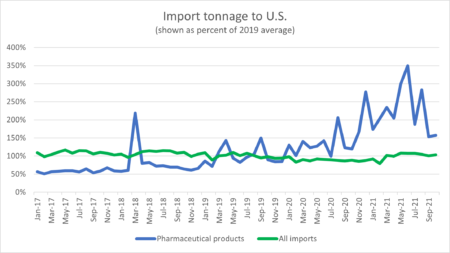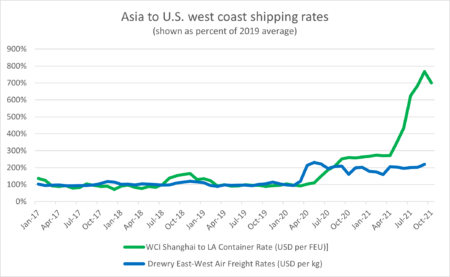Experts at RSM share how life sciences companies can adapt to supply chain crisis
Back
Life sciences supply chains have become increasingly globalized, and while reliance on Asia has increased, the headline issue of congestion seen at ports has had less of an impact on biopharma and medical devices companies than for the broader U.S. economy.
“We have seen an increase in shipping costs for life sciences products, but because of the high value to weight ratio, much of the transpacific shipping is via air not sea. Costs and time frames have increased, but nothing like what we have seen with the ports,” said Adam Lohr, RSM partner and senior life sciences analyst. “In fact, shipping volumes are still well above their pre-pandemic levels.”

Source: Bloomberg, RSM US LLP

Source: Bloomberg, RSM US LLP
Chips and semiconductors, and other high value inputs do impact life sciences companies, –but the most mission critical component will continue to be a highly skilled work force. That’s why experts at RSM argue the labor shortage is the greatest supply chain challenge facing the industry.
The pandemic has accelerated the shift to a remote and digitized workforce, and STEM skills are in demand across the economy, creating a very real battle for talent. Baby boomers are retiring early (4.2 million during the pandemic), and women are leaving the workforce at a faster rate than any other demographic.
“The ecosystem of life sciences is heavily dependent upon these highly-skilled women. More than 60% of biology graduates are women.” Lohr said. “And they’re facing a disproportionate amount of pressure to leave the workforce. Until those pressures are alleviated, labor will continue to be a challenge.”
Whether the focus is on short-term supply constraints or long-term strategy innovation, Lohr encourages his clients to assess their people, processes, and technology. Labor constraints don’t have easy or quick solutions in our current labor market, but Lohr said there are three things companies can do to adapt.
The first? Look close to home.
“There are always internal efficiencies you can gain,” he said. “There is so much out of our control right now, so look internally. Make sure your house is in order.”
Then, companies should invest in the right tools and technologies, such as productivity-enhancing software, equipment, and intellectual property.
“Leverage technology to make your existing workforce more efficient–that’s the best opportunity you have,” Lohr said. “It’s about enabling your workforce, not replacing them.”
He advises companies to Invest in technology now for the future because the shift in labor requirements will likely be more structural than temporary.
“These challenges we’re seeing now? We need to get used to them,” Lohr said.
RSM’s third piece of advice is to consider outsourcing. Companies can strategically outsource research, manufacturing, IT, HR, accounting, or other functions that allow organizations to focus on their core efforts and key components. With the talent crisis, specialization is going to become critical and demand a wage premium. Outsourcing is a way to avoid fixed labor costs.
Lohr said the supply chain issues will be resolved in time, and the life sciences industry will come out of it with more resilient practices. The pandemic has put a renewed focus on speed, resiliency and reliability of supply chains, with recent moves in domestic policy including Buy America and the new infrastructure bill, he predicts life sciences will begin looking at more domestic production and nearshoring.
“I’m only optimistic,” he said. “Life sciences has made itself so resilient over the last several decades that it can weather a storm like this. Supply chain has always been front of mind because the products are so critically important.”
For more life sciences businesses insights, read RSM’s industry outlook.
